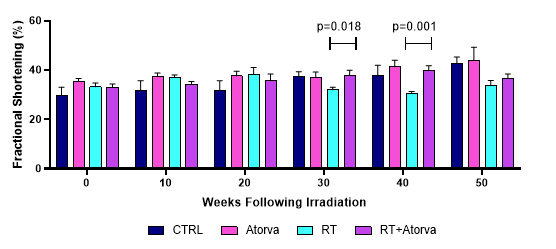Mitigative potential of statin therapy in base-mediated radiation cardiotoxicity
OC-0598
Abstract
Mitigative potential of statin therapy in base-mediated radiation cardiotoxicity
Authors: Gerard Walls1, Mihaela Ghita1, Refik Kuburas1, Kevin Edgar2, Chris Watson2, David Grieve2, Aidan Cole3, Karl Butterworth1
1Queen's University Belfast, Patrick G Johnston Centre for Cancer Research, Belfast, United Kingdom; 2Queen's University Belfast, Wellcome-Wolfson Institute For Experimental Medicine, Belfast, United Kingdom; 3Belfast City Hospital, Northern Ireland Cancer Centre, Belfast, United Kingdom
Show Affiliations
Hide Affiliations
Purpose or Objective
Despite modern advances, radiation cardiotoxicity (RC) is common among patients with lung and oesophageal cancer, including infarction and arrhythmia. The pathophysiology explaining these processes is a combination of endothelial dysfunction, connective tissue dysregulation and cardiomyocyte necrosis. Dose and/or volume dependence for RC is lacking but recently the dose received by the base region has been correlated with worse survival. Statin therapy has been shown to reduce short-term functional effects of whole-heart irradiation in murine models, most likely owing to their pleiotropic antioxidant and anti-inflammatory properties on the target tissues listed. Here a 50-week study serially assessing functional parameters in mice receiving base-targeted heart irradiation, with concomitant statin therapy, was conducted.
Material and Methods
Female C57BL/6 mice (n=58) received 16Gy/1# to the cranial third of the heart using image-guidance on a small animal radiotherapy research platform, or atorvastatin therapy alone, or both. The animals were monitored with serial echo- and electrocardiography (ECG) every 10 weeks, and blood, and heart collections at 10, 30 and 50 weeks. Serum atrial natriuretic peptide (ANP) was analysed from blood retrieved at the point of animal tissue collection.
Results
At 30 and 40 weeks a statistically significant reduction in the left ventricular (LV) fractional shortening was observed in the animals receiving radiation alone, compared to the animals receiving concomitant atorvastatin (p=0.018, p=0.00, Figure 1). A similar trend was observed in LV ejection fraction also, in keeping with LV systolic dysfunction at these time-points. No significant differences were detected in E/a ratio between groups, suggesting diastolic function was preserved. Analysis of ECGs revealed increased PR interval following base irradiation at 10 weeks and 30 weeks, in keeping with potential atrioventricular node pathology. The P wave duration was also increased at 30 weeks, which is suggestive of abnormal conduction throughout the atria. The QRS widths were fairly consistent throughout the study indicating ventricular conduction was largely preserved following base irradiation. Plasma ANP levels were shown to be similar across groups, with a drop following irradiation at 10 weeks followed by a rebound increase, which was larger in the animals receiving atorvastatin. ANP levels were subsequently lower at 50 weeks, and less so in the animals receiving atorvastatin.

Conclusion
Provisional analyses indicate that atorvastatin protects against LV dysfunction following cardiac base irradiation, and this observation was matched with less pronounced reductions in ANP. Together with signals from retrospective clinical data, these data may provide the rationale for a clinical trial of statin therapy for the mitigation of RC.